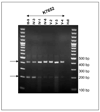Large intron 14 rearrangement in APC results in splice defect and attenuated FAP
- PMID: 20033212
- PMCID: PMC3159508
- DOI: 10.1007/s00439-009-0776-9
Large intron 14 rearrangement in APC results in splice defect and attenuated FAP
Abstract
Familial adenomatous polyposis [FAP (OMIM 175100)] is an autosomal dominant colorectal cancer predisposition syndrome characterized by hundreds to thousands of colonic polyps and, if untreated by a combination of screening and/or surgical intervention, an approximately 99% lifetime risk of colorectal cancer. A subset of FAP patients develop an attenuated form of the condition characterized by lower numbers of colonic polyps (highly variable, but generally less than 100) and a lower lifetime risk of colorectal cancer, on the order of 70%. We report the diagnosis of three attenuated FAP families due to a 1.4-kb deletion within intron 14 of APC, originally reported clinically as a variant of unknown significance (VUS). Sequence analysis suggests that this arose through an Alu-mediated recombination event with a locus on chromosome 6q22.1. This mutation is inherited by family members who presented with an attenuated FAP phenotype, with variable age of onset and severity. Sequence analysis of mRNA revealed an increase in the level of aberrant splicing of exon 14, resulting in the generation of an exon 13-exon 15 splice-form that is predicted to lead to a frameshift and protein truncation at codon 673. The relatively mild phenotypic presentation and the intra-familial variation are consistent with the leaky nature of exon 14 splicing in normal APC. The inferred founder of these three families may account for as yet undetected affected branches of this kindred. This and similar types of intronic mutations may account for a significant proportion of FAP cases where APC clinical analysis fails because of the current limitations of testing options.
Figures






Similar articles
-
Intron 4 mutation in APC gene results in splice defect and attenuated FAP phenotype.Fam Cancer. 2004;3(1):35-40. doi: 10.1023/B:FAME.0000026824.85766.22. Fam Cancer. 2004. PMID: 15131404
-
A novel pathogenic splice acceptor site germline mutation in intron 14 of the APC gene in a Chinese family with familial adenomatous polyposis.Oncotarget. 2017 Mar 28;8(13):21327-21335. doi: 10.18632/oncotarget.15570. Oncotarget. 2017. PMID: 28423518 Free PMC article.
-
Familial adenomatous polyposis: aberrant splicing due to missense or silent mutations in the APC gene.Hum Mutat. 2004 Nov;24(5):370-80. doi: 10.1002/humu.20087. Hum Mutat. 2004. PMID: 15459959
-
APC-Associated Polyposis Conditions.1998 Dec 18 [updated 2022 May 12]. In: Adam MP, Feldman J, Mirzaa GM, Pagon RA, Wallace SE, Amemiya A, editors. GeneReviews® [Internet]. Seattle (WA): University of Washington, Seattle; 1993–2025. 1998 Dec 18 [updated 2022 May 12]. In: Adam MP, Feldman J, Mirzaa GM, Pagon RA, Wallace SE, Amemiya A, editors. GeneReviews® [Internet]. Seattle (WA): University of Washington, Seattle; 1993–2025. PMID: 20301519 Free Books & Documents. Review.
-
Genetic testing for familial adenomatous polyposis.Ann N Y Acad Sci. 2000 Jun;910:36-47; discussion 47-9. doi: 10.1111/j.1749-6632.2000.tb06699.x. Ann N Y Acad Sci. 2000. PMID: 10911904 Review.
Cited by
-
Alternative splicing within the Wnt signaling pathway: role in cancer development.Cell Oncol (Dordr). 2016 Feb;39(1):1-13. doi: 10.1007/s13402-015-0266-0. Epub 2016 Jan 13. Cell Oncol (Dordr). 2016. PMID: 26762488 Review.
-
Constitutional chromothripsis of the APC locus as a cause of genetic predisposition to colon cancer.J Med Genet. 2022 Oct;59(10):976-983. doi: 10.1136/jmedgenet-2021-108147. Epub 2021 Dec 14. J Med Genet. 2022. PMID: 34911816 Free PMC article.
-
Motifs within the CA-repeat-rich region of Surfactant Protein B (SFTPB) intron 4 differentially affect mRNA splicing.J Mol Biochem. 2013 Feb 20;2(1):40-55. J Mol Biochem. 2013. PMID: 23687636 Free PMC article.
-
IFN/STAT signaling controls tumorigenesis and the drug response in colorectal cancer.Cancer Sci. 2019 Apr;110(4):1293-1305. doi: 10.1111/cas.13964. Epub 2019 Mar 22. Cancer Sci. 2019. PMID: 30724425 Free PMC article.
-
Contribution of APC and MUTYH mutations to familial adenomatous polyposis susceptibility in Hungary.Fam Cancer. 2016 Jan;15(1):85-97. doi: 10.1007/s10689-015-9845-5. Fam Cancer. 2016. PMID: 26446593 Free PMC article.
References
-
- A comprehensive genetic linkage map of the human genome. NIH/CEPH Collaborative Mapping Group. Science. 1992;258(5079):67–86. - PubMed
-
- Aretz S, Uhlhaas S, Sun Y, Pagenstecher C, Mangold E, Caspari R, Moslein G, Schulmann K, Propping P, Friedl W. Familial adenomatous polyposis: aberrant splicing due to missense or silent mutations in the APC gene. Hum Mutat. 2004;24(5):370–380. - PubMed
-
- Bala S, Kraus C, Wijnen J, Meera Khan P, Ballhausen WG. Multiple products in the protein truncation test due to alternative splicing in the adenomatous polyposis coli (APC) gene. Hum Genet. 1996;98(5):528–533. - PubMed
-
- Bala S, Sulekova Z, Ballhausen WG. Constitutive APC exon 14 skipping in early-onset familial adenomatous polyposis reveals a dramatic quantitative distortion of APC-gene specific isoforms. Hum Mutat. 1997;10(3):201–206. - PubMed
Publication types
MeSH terms
Substances
Grants and funding
LinkOut - more resources
Full Text Sources
Miscellaneous

